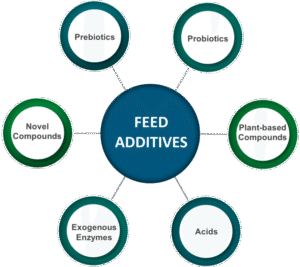The most recent data concerning ideal amino acid ratios are based on
amino acids digested in the ileum in order to take into consideration
the influence of amino acid losses during digestion and absorption.
Further data for individual species can be found in chapter 8 “Amino
acid responses and recommendations”.
Since poultry have different requirements for some essential amino
acids, namely the sulphur containing amino acids for feather growth,
they have a different “ideal amino acid profile” to pigs. The requirement
for essential amino acids for the basic maintenance of the
animal compared with the requirement for growth changes with increased
liveweight hence the ideal amino acid profile may change
with increasing liveweight.
In the case of ruminant animals, especially dairy cow, lysine and methionine
have been identified most frequently as first-limiting amino
acids for both growth and milk protein production. The “ideal amino
acid profile” or since protein provides amino acids, the “ideal protein”
requirement, differs from one animal species to another and within
an animal species differs depending on age and level of production.
This is because the requirements for specific essential amino acids
and hence the ratio, differs between species and differs according to
the requirement in the body whether it be for maintenance, growth or
reproduction. The concept of “ideal protein” helps considerably the
task of the feed formulator. If the dietary requirements of an animal
in terms of lysine are known and the ideal amino acid profile for that
animal and stage of production is known, then the requirement for all
the other amino acids can be estimated.
Thank you for reading. Don't forget to subscribe & share!
Amino acid digestibility
Proteins cannot be absorbed intact through the walls of the intestine,
the molecules are too large. Thus for an amino acid contained in a
feed protein to reach the site of protein synthesis, it must be released
from its parent protein. Release from the parent protein occurs during
digestion in the gut after which either the individual amino acids or
as di- and tri-peptides are absorbed through the intestinal wall (see
chapter 3.1. on Digestion and Absorption). Hence factors which have
an influence on digestion and absorption in the animal also play a key
role in the animal nutrition.
The notion of digestibility has gradually developed on both a methodological
and a conceptual level. Digestibility, which was initially
measured at the fecal level, is now measured at the ileal level, due to
changes caused by the microflora of the large intestine. On the one
hand, undigested amino acids on the ileal level can be catabolised by
the microflora of the large intestine or used for the synthesis of microbial
protein. On the other hand, some amino acids are synthesized
de novo by bacteria without being absorbed by the animal; these
eventually end up in the faeces. Ileal digestibility therefore represents
the absorption of amino acids in the digestive tract far better than fecal
digestibility. However, the profile of amino acids at the end of the
small intestine is not the only result of the absorption of dietary amino
acids. The digestive process is also accompanied by secretions of
digestive enzymes and cell desquamations, whose protein elements
blend with the proteins of dietary origin in the intestinal lumen. These
secretions are partially digested and reabsorbed, but some of them,
escape this re-absorption. This fraction of endogenous origin can be
measured by feeding the animal with a protein-free diet. Although this
technique only enables basal endogenous or non-specific losses to
be measured, it makes it possible to propose corrected apparent ileal
digestibility coefficients which are called true or standardized, meaning
corrected for the basal endogenous losses.
Furthermore, if the endogenous secretion of amino acids is estimated,
then the standardized ileal digestibility may be calculated. Diet
formulation based on ileal digestible amino acids gives a more accurate
estimate of the amino acids available to the animal and is of
greatest value with poor digestibility feedstuffs.
Differences in the digestibility of individual amino acids are an inherent
characteristic of different raw materials. The digestibility coefficients
of different amino acids in a range of raw materials for monogastrics
are shown in Table 4. The percentages of digestible amino acids
in ruminants for a range of feed materials are presented in Table 5.
The values have been drawn from a number of different sources and
therefore represent a wide range of experimental techniques.
With respect to the nutritional evaluation of feedstuffs the information
in Table 4 and Table 5 represents a major advance compared with the
use of total amino acid content. If the evaluation of digestibility is carried
out at the end section of the small intestine (terminal ileum) the
effect of microbiological conversion which occurs in the large intestine
is essentially eliminated.









